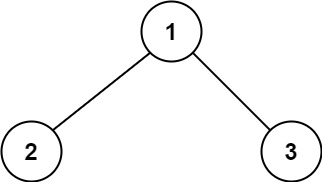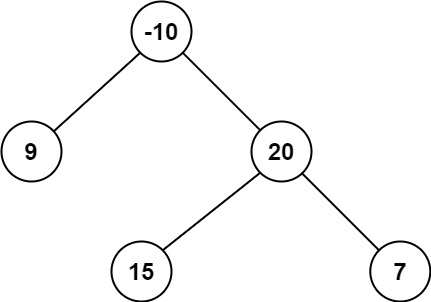原文链接: https://leetcode-cn.com/problems/binary-tree-maximum-path-sum
英文原文
A path in a binary tree is a sequence of nodes where each pair of adjacent nodes in the sequence has an edge connecting them. A node can only appear in the sequence at most once. Note that the path does not need to pass through the root.
The path sum of a path is the sum of the node's values in the path.
Given the root of a binary tree, return the maximum path sum of any non-empty path.
Example 1:

Input: root = [1,2,3] Output: 6 Explanation: The optimal path is 2 -> 1 -> 3 with a path sum of 2 + 1 + 3 = 6.
Example 2:

Input: root = [-10,9,20,null,null,15,7] Output: 42 Explanation: The optimal path is 15 -> 20 -> 7 with a path sum of 15 + 20 + 7 = 42.
Constraints:
- The number of nodes in the tree is in the range
[1, 3 * 104]. -1000 <= Node.val <= 1000
中文题目
路径 被定义为一条从树中任意节点出发,沿父节点-子节点连接,达到任意节点的序列。同一个节点在一条路径序列中 至多出现一次 。该路径 至少包含一个 节点,且不一定经过根节点。
路径和 是路径中各节点值的总和。
给你一个二叉树的根节点 root ,返回其 最大路径和 。
示例 1:

输入:root = [1,2,3] 输出:6 解释:最优路径是 2 -> 1 -> 3 ,路径和为 2 + 1 + 3 = 6
示例 2:

输入:root = [-10,9,20,null,null,15,7] 输出:42 解释:最优路径是 15 -> 20 -> 7 ,路径和为 15 + 20 + 7 = 42
提示:
- 树中节点数目范围是
[1, 3 * 104] -1000 <= Node.val <= 1000
通过代码
高赞题解
最后修改于:2021-11-01
思路
路径每到一个节点,有 3 种选择:1. 停在当前节点。2. 走到左子节点。3. 走到右子节点。
走到子节点,又面临这 3 种选择,递归适合处理这种规模不同的同一问题。
注意,不能走进一个分支又掉头回来走另一个分支,路径会重叠,不符合题目要求。

定义递归函数
- 对于一个父节点,它关心自己走入一个子树,从中捞取的最大收益,不关心具体怎么走。
定义dfs函数:返回当前子树能向父节点“提供”的最大路径和。即,一条从父节点延伸下来的路径,能在当前子树中捞取的最大收益。分为三种情况:
路径停在当前子树的根节点,在当前子树的最大收益:
root.val走入左子树,在当前子树的最大收益:
root.val + dfs(root.left)走入右子树,在当前子树的最大收益:
root.val + dfs(root.right)
- 这对应了前面所说的三种选择,最大收益取三者最大:
root.val+max(0, dfs(root.left), dfs(root.right))
- 再次提醒: 一条从父节点延伸下来的路径,不能走入左子树又掉头走右子树,不能两头收益。
- 当遍历到
null节点时,null 子树提供不了收益,返回 0。
- 如果某个子树 dfs 结果为负,走入它,收益不增反减,该子树应该被忽略,杜绝走入,像对待 null 一样让它返回 0(壮士断腕)。

子树中的内部路径要包含根节点
题意可知,最大路径和,是可能产生于其中一个子树中的,就好比下图左一。
所以每递归一个子树,都求一下当前子树内部的最大路径和,见下图右一的绿字,从中比较出最大的。
- 注意: 一个子树内部的路径,要包含当前子树的根节点。如果不包含,那还算什么属于当前子树的路径,那就是当前子树的子树的内部路径了。
- 所以,一个子树内部的最大路径和 = 左子树提供的最大路径和 + 根节点值 + 右子树提供的最大路径和。即
dfs(root.left)+root.val+dfs(root.right)

代码
时间复杂度 $O(N)$,每个节点都要遍历,空间复杂度是 $O(H)$,递归树的深度。
[]const maxPathSum = (root) => { let maxSum = Number.MIN_SAFE_INTEGER; // 最大路径和 const dfs = (root) => { if (root == null) { // 遍历到null节点,收益0 return 0; } const left = dfs(root.left); // 左子树提供的最大路径和 const right = dfs(root.right); // 右子树提供的最大路径和 const innerMaxSum = left + root.val + right; // 当前子树内部的最大路径和 maxSum = Math.max(maxSum, innerMaxSum); // 挑战最大纪录 const outputMaxSum = root.val + Math.max(0, left, right); // 当前子树对外提供的最大和 // 如果对外提供的路径和为负,直接返回0。否则正常返回 return outputMaxSum < 0 ? 0 : outputMaxSum; }; dfs(root); // 递归的入口 return maxSum; };
[]func maxPathSum(root *TreeNode) int { maxSum := math.MinInt32 var dfs func(root *TreeNode) int dfs = func(root *TreeNode) int { if root == nil { return 0 } left := dfs(root.Left) right := dfs(root.Right) innerMaxSum := left + root.Val + right maxSum = max(maxSum, innerMaxSum) outputMaxSum := root.Val + max(left, right) // left,right都是非负的,就不用和0比较了 return max(outputMaxSum, 0) } dfs(root) return maxSum } func max(a, b int) int { if a > b { return a } return b }
复盘总结
递归一个树,会对每个子树做同样的事(你写的处理逻辑),所以你需要思考要对每个子树做什么事,即思考子问题是什么,大问题怎么拆解成子问题。
通过求出每个子树对外提供的最大路径和(return出来给父节点),从递归树底部向上,不断求出了每个子树内部的最大路径和,后者是求解的目标,它的求解需要子树提供的值,搞清楚二者的关系。
每个子树的内部最大路径和,都挑战一下最大纪录,递归结束时,最大纪录就有了。
思考递归问题,不要纠结细节实现,内部细节是子递归帮你去做的,应结合求解的目标,自顶而下、屏蔽细节地思考,思考递归子问题的定义。随着递归出栈,子问题自下而上地解决,最后解决了整个问题。
所以要做的只是写好递归的处理逻辑,怎么处理当前子树?需要返回什么吗?怎么设置递归的出口?
没有思路的时候,试着画画递归树找思路。就算做对了,画图也能加深对递归算法的理解。
我时不时读改本文,常读常新,力求准确清晰,毫无保留,你也应该感受到这份真诚。
谢谢收看。
统计信息
| 通过次数 | 提交次数 | AC比率 |
|---|---|---|
| 173109 | 388462 | 44.6% |
提交历史
| 提交时间 | 提交结果 | 执行时间 | 内存消耗 | 语言 |
|---|
相似题目
| 题目 | 难度 |
|---|---|
| 路径总和 | 简单 |
| 求根节点到叶节点数字之和 | 中等 |
| 路径总和 IV | 中等 |
| 最长同值路径 | 中等 |




